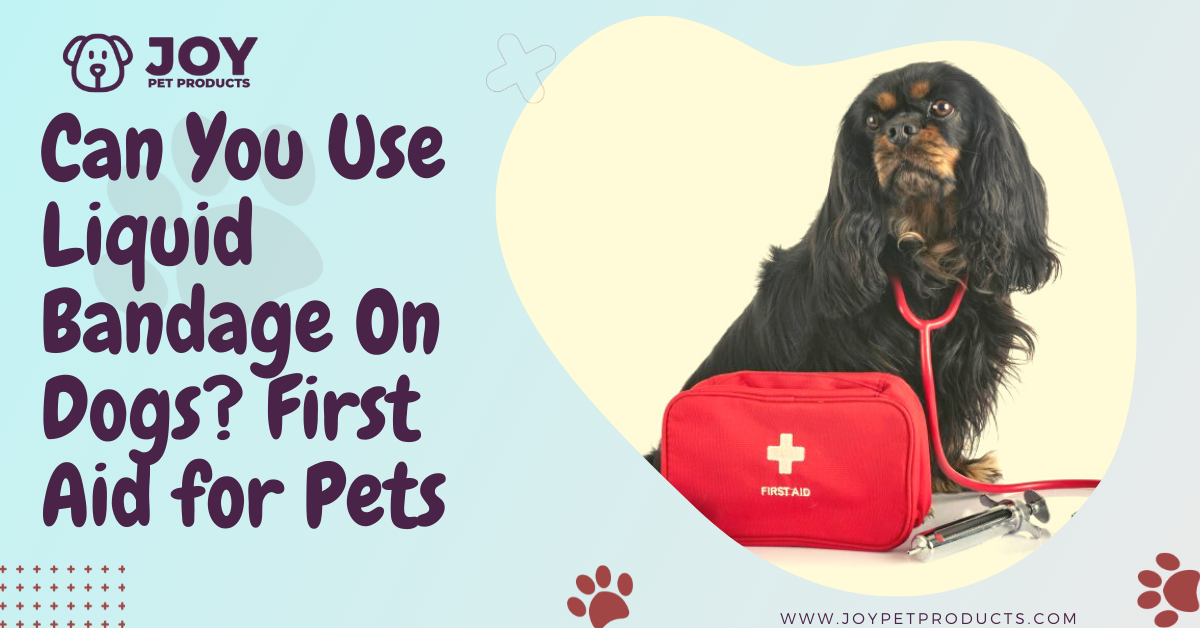As a dog parent, you must be ready to care for your pets in emergencies. Dogs, by nature, are curious creatures who like to explore their surroundings. Unfortunately, their boisterous trait can lead to minor cuts, scrapes, bruises, and sometimes serious injuries.
First aid is the way you can care for your pets in case of medical emergencies and register appropriate treatment. It can help reduce discomfort, stop blood loss, and minimize long-term damage. In severe cases, it can potentially save the pet’s life before you reach the vet’s clinic.
You can care for small cuts and scrapes at home. Liquid bandages are a convenient way of taking care of small wounds. But can you use liquid bandage on dogs? Yes, you can. But, there are some instructions you need to follow when using them on dogs.
The article will take you through liquid bandages, picking the right type and using them correctly on your pets.
What Are Liquid Bandages?

Licking is the dog’s way of soothing any pain, discomfort, or irritation. You may cover up the area with gauze to prevent licking when your dog has a minor cut. But constant activity can cause the gauze to fall away. The dog mat scratch or bite off the traditional bandage.
This can be dangerous as the dog’s mouth contains bacteria. And licking with that bacteria-filled mouth can lead to wound infection.
Yelling at the animal does not help, as it does not understand why it is not supposed to lick the wound. So, what else can you do?
You can use liquid bandages formulated especially for your furry friends. It is a topical skin treatment. Also known as a tissue adhesive, it can be applied as a spray or foam to the wound. It has a sticky polymer compound that bonds together the edges of the wound.
The bandage can seal the wound and help stop bleeding. It can keep harmful bacteria out and maintain moisture levels to aid quick healing. In addition, it reduces the chances of the wound getting infected.
Can You Use Liquid Bandage On Dogs?
You can use these bandages on dogs for small wounds and cuts. If the cut is deep, blood or other discharge is oozing out; it needs vet care. If the wound is small and uninfected, you can go ahead with a liquid bandage.
If your dog gets fussy around traditional bandages, the liquid version will work best for them. Once you apply the bandage, it seals the wound in a matter of minutes. The application process is painless for the pet and is convenient and quick for you.
In case of any wound, restricting activity would be ideal. But, a liquid bandage will not hinder your pet’s movement like its traditional counterpart. Some of these bandages are waterproof, ensuring the dog can go about its day without affecting the healing process.
A single application is enough to close the wound. The seal can last anywhere from 5 to 10 days. At which point, the minor wound should have healed itself.
Is Using Human Liquid Bandage on Dogs Safe?

Human liquid bandages are not dangerous to pets. In an ideal scenario, though, you should not use human liquid bandages on dogs.
These bandages contain alcohol which can cause a burning sensation or irritate your dog’s skin. Human skin is 18 to 20 layers thick and can handle the alcohol and chemicals used. A dog’s skin, though, is 8 to 10 layers thick and may not be able to handle the ingredients of a human liquid bandage. It can also slow down wound healing.
If the dog has an unpleasant experience, it will remember it and not let you use liquid bandages in the future.
Human liquid bandages can take longer to seal than those formulated for pets. With this, you risk the pet licking the solution before the wound is sealed. In addition, the harsher chemicals used may be toxic to a pet if ingested in large amounts. If you use a human liquid bandage in an emergency, place an E-collar on the dog to avoid unnecessary licking.
So, to summarize, it would be best if you stuck to liquid bandages made for pets.
How to Use Liquid Bandage on Dogs?
First, make sure the wound is dry and clean. If you see any dirt or debris, wash it with warm water and pat it dry with a clean towel or rag.
Shake the bottle well, then spray the liquid bandage on the affected area from a distance of 4 to 6 inches. Depending on the wound and the brand you are using, it should take 1 to 3 minutes for the spray to dry.
You will notice that the solution has transformed into a non-sticky, waterproof film, and the wound is closed shut.
You can reapply the bandage as required. However, do clean the area before every application.
Where Can You Use Liquid Bandage?

You can use liquid bandages on small wounds and scrapes. You can also use it to soothe minor skin irritation, hotspots, and ulcers.
Using traditional bandages on areas such as ears, nose, paws, and tail can be challenging. For example, you may not be able to roll the bandage over. Or, if you did, it may not stay in place due to the constant movement and fidgeting from the pet.
So, here is where the convenient liquid bandage comes into play. Generally, use these bandages only when the pet does not require immediate medical care.
Keep in mind these points when using a liquid bandage on dogs:
- The wound should be less than 4 cm and superficial.
- The wound edge should ideally be linear to the skin.
- It is ok if the wound is bleeding slightly.
- The wound is an area where it is at risk of reopening, like the nose or paws.
Where Can You Not Use Liquid Bandage?

Can you use liquid bandage on dogs? Yes, you may, but you should also know when not to use it.
If the dog has a deep, gaping wound, the liquid bandage is not the way to go—for example, deep lacerations from dashing against a foreign object or bite marks from another animal.
In such cases, the wound will have to be cleaned and disinfected. Then, depending on the damage, it may be stitched up or left open to aid the healing process.
If the wound is small, but you see blood, pus, or other discharge oozing out, or if the wound edges are swollen, the wound could already be infected. A liquid bandage here can trap the bacteria inside and worsen the infection.
Minor wounds equivalent to a human scraped knee can be left open. These scrapes can heal faster with the outside air.
When applying a liquid bandage, do not use it too close to the eyes or nose. Also, do not use to tend to any internal wounds, like the ones in your dog’s mouth. A liquid bandage is not to be ingested by the dog.
How to Care for a Dog After Using Liquid Bandage?

Once you have applied a liquid bandage, ensure the dog’s activity is restricted to a certain limit to avoid the wound from reopening.
The bandage is waterproof, so bathing the pet should be ok. But do not overdo it. You can use the normal shampoo and water routine, but do not scrub the wound site. Also, avoid applying any additional ointment to the area. These activities can loosen the adhesive bond and cause the wound to reopen.
If your dog will not stop from obsessively licking at the wound, use an E-collar to prevent the behavior.
Bonus Read: Ultimate Guide To Dog Health
When Should You Reach Out to the Vet?

Applying a liquid bandage is not the end of wound care. First, you need to monitor the area for signs of infection. For example, if the wound site has swollen, there is pus or rash around the skin, the wound needs to be looked at by the vet.
You should also visit the vet if your dog shows additional signs like:
These are signs that the dog has an infection. You may not have cleaned the wound properly, or bacteria could have found their way in. Regardless, the dog will need antibiotics to fight off the infection.
How to Pick the Right Type of Liquid Bandage?
It would be best if you were careful when picking medical products for your pets. You should know what products are used in the liquid bandage and the effect they offer.
Here are some points that can help you pick the right liquid bandage for your dog.
- Alcohol-Free: As mentioned above, your dog’s skin is sensitive, so it may not react well to a human liquid bandage. In addition, the wound may already be burning, and using an alcohol-laden bandage will make the dog feel worse. This negates the point of using a convenient and painless first-aid form. So when choosing a bandage for the pet, ensure it is alcohol-free.
- Fast Drying: A few brands take a couple of minutes to polymerize and form a seal. Other brands close the wound in a few seconds. For the dog, licking is a way to reduce pain. If your pet is fussy or aggressive and will not sit still and lick at the wound, you must pick a fast-drying liquid bandage.
- Antiseptic: Your dog’s skin and mouth naturally have bacteria. So even if you have cleaned the area, there are chances that bacteria may have made their way inside the wound. A liquid bandage with an antiseptic will help kill the bacteria around the cut. This reduces the chances of the wound being infected.
- Anesthetic: Cuts and wounds, even the smallest ones, can sting, be uncomfortable, and painful. Your furry friends may not explicitly be able to tell you this, but they could be in discomfort and pain. A liquid bandage with an anesthetic can provide much-needed relief to your pet. It can soothe the pain and aid healing.
- Bitter to Taste: As soon as you apply the liquid bandage, the dog will try to lick at the wound. However, excessive licking can break the bond resulting in the wound reopening. If the bandage is bitter to taste, it will prevent the dog from picking at the wound. This will ensure the healing process proceeds unhindered.
What Should a Pet First-Aid Kit Contain?

You can buy the pre-packaged first-aid kits available for pets in the market. Or, if you prefer, you can make your emergency kit by buying the supplies separately.
Regardless of whether you buy or make your own, here are a few essentials that should be present in the kit:
- Sterile gauze
- Bandages
- Small clean towels or rags
- Scissors
- Tweezers
- Adhesive tape
- Antiseptics like hydrogen peroxide
- Antibiotic spray or ointment
- Soft muzzle
- E-collar
How to Provide First-Aid for Common Dog Conditions and Emergencies?

Assess if the dog needs immediate medical care. For example, the dog could be bleeding, burnt or suffering from a heat stroke, or having seizures.
You surely need to get the vet for proper treatment, but it is the first aid you can provide in the meantime.
- Bleeding: If the dog has a cut or a gaping wound, your priority should be to stop the bleeding. Applying light pressure on the wound by placing a clean towel can help stop the bleeding. You can cover the wound with traditional bandages. In case of bleeding, you can place the cotton on top and add another layer of bandage. Covering the wound this way can help while transporting the pet to the vet’s clinic.
- Burns: If your dog has suffered from a burn or a scald, first run cold water over the area. Do this for a minimum of 5 minutes. Next, cover the area with damp towels. Avoid applying any topical or ointment to the burned area. Call the vet for a further course of action.
- Heat Stroke: A dog can suffer heat stroke if they have been out in the sun for too long, running or exercising without enough water. Or they have been left in a car on a hot day without proper ventilation. If the dog is panting heavily and is severely distressed, move it under a cool shade. Wet the dog’s cat with tepid water. Do not use ice-cold water as it can drastically reduce the dog’s body temperature, resulting in other complications.
- Seizures: If the dog is having a fit or a seizure, you need to let it runs its course. If you touch the dog in between, it can act as stimulation and increase the episode’s length. Please do not attempt to hold its tongue, as you can get bit in the process. Draw the curtains, darken the room and reduce the noise level to the lowest. Call the vet for further advice. When tending to a medical emergency, you must remain calm and assess the dog’s situation. Dogs can themselves be frightened or in pain, and you attempting to rescue them the wrong way can put both the dog and you in harm’s way. Have the vet’s number handy, call them up, and explain the case.
Summary
Can you use liquid bandage on dogs? Yes, you can. These bandages are quick and painless to deal with minor cuts and scrapes.
These bandages offer several advantages; they are easy to apply in hard-to-get areas, fast-drying, waterproof, stays in place, and reduce discomfort and pain for the pet.
For these advantages, ensure you pick liquid bandages made especially for pets. Pick a brand that is alcohol-free, quick-drying, and has an antiseptic, anesthetic, and bitter taste.
If the wound is big, continues to bleed, has a discharge or the pet has fever, lethargy, or nausea, please get in touch with the vet immediately.
Heather Abraham is a professional blogger who owns two dogs, a cat, a parrot, and a leopard gecko. She has a connection with animals since she was a child. She shares her love for all pet breeds and provides information on pet food, toys, medications, beds, and everything else.
She is committed to learning about the internal workings of animals. Her work permits her to work closely with knowledgeable vets and obtain practical expertise in animal care. When she is not working, her love of animals continues in her writing. Her goal is to educate and uplift readers who also have a passion for animals through her writing.
